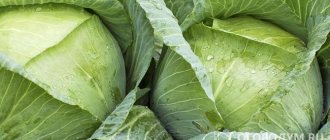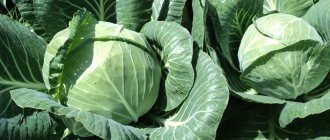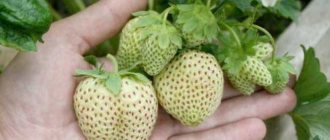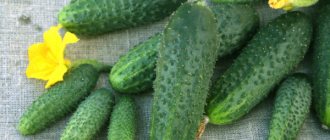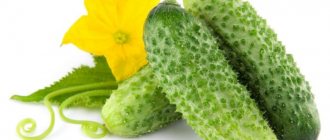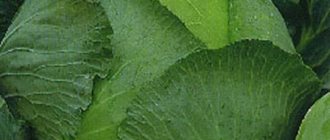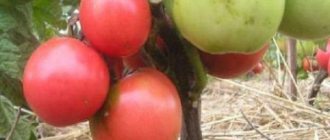Nadezhda cabbage is a mid-season hybrid of domestic selection. It was created in 1969 at the station of the Research Institute of Vegetable Farming (NIIOKH). To breed the hybrid, 2 varieties were used: Slava Enkhuizen and Densely Headed. In 1975, cabbage was included in the State Register. The hybrid is recommended for cultivation in the following regions of the country:
- Far Eastern.
- East Siberian.
- West Siberian.
- Srednevolzhsky.
- Nizhnevolzhsky.
- Uralsk.
- Volga-Vyatka.
- Central Chernozem.
- North-West.
- Central.
In the article you will find a description of the variety, photos of hybrid heads and reviews of gardeners who cultivated the vegetable on their site.
Description of Nadezhda cabbage
The Nadezhda cabbage variety is valued primarily for the density of heads of cabbage and high, stable yield, little dependent on weather conditions. She is rarely affected by disease.
The leaf rosette of young cabbage Nadezhda looks semi-spreading in the photo. The upper leaves are large, with a wavy edge. The color of the leaves is from green to dark green, with a pronounced waxy coating. The head of cabbage itself is formed by light green leaves. The waxy coating is absent or insignificant, almost invisible to the eye. The cut is white, with a short stalk and no voids.
Nadezhda cabbage produces flat-rounded, even-sized heads of cabbage with an average weight of 3-3.5 kg. The heads of cabbage are very dense, the leaves adhere well to each other.
According to descriptions of the variety and reviews from gardeners, the taste of Nadezhda cabbage is rated as excellent. The leaves, despite their increased density, are quite thin and remain juicy and tender for a long time. They have a sweetish taste.
White cabbage Nadezhda is an unpretentious variety. The main problem for vegetable growers in the middle zone is the need to grow it through seedlings. In addition, the Nadezhda variety, like most types of cabbage, is demanding on site lighting and soil fertility. The fact that plants are rarely affected by pests makes care much easier.
Cabbage variety Nadezhda, a description and photo of which is given in the article, is zoned for all regions of the Russian Federation, with the exception of the Far North. Excellent characteristics allow it to be grown in the unstable climate of the middle zone, short daylight hours in the northern and northwestern regions and in the arid southern regions.
Table with brief characteristics
| Variety or hybrid | variety |
| Ripening time | average |
| Kochan | round, round-flat, dense |
| Kocheryzhka | short |
| Disease resistance | average |
| Fruit weight, g | 2500-3400 |
| Growing areas | the entire post-Soviet space, in the Russian Federation with the exception of the Northern and North Caucasus regions |
| Disembarkation scheme | 70x70 cm |
| From germination to ripeness | 115-135 days |
| Seed placement depth | 1.5 cm |
| Seedling age | 30-45 days |
| Soil temperature for planting seeds/seedlings | 4/ 12 |
| Advantages | excellent transportability, stored until spring, not afraid of short-term drought, practically does not crack, excellent taste, does not throw flower stalks for a long time |
| Flaws | does not tolerate shading, does not like excessive humidity |
Diseases and pests
Nadezhda cabbage has high immunity to most diseases, including gray rot. To achieve good results for disease prevention, crop rotation is observed. Cabbage should not be planted after other cruciferous vegetables, which include radishes, daikon, and turnips. These vegetables should not be planted next door either.
The Nadezhda variety is rarely affected by pests. However, in hot and dry years, planting may be attacked by the cruciferous flea beetle. Vegetable growers have many traditional ways to combat this pest, including mulching the soil with ash or treating the plantings with an infusion of hot pepper.
Planting care
To obtain consistently high yields, Nadezhda cabbage must be properly cared for.
For pests and diseases you can use “Fitoverm”, “Iskra D”
- Water for irrigation is always taken warm, standing in the sun. Water at the root so as not to get on the leaves. This procedure must be done so that the ground is slightly damp all the time.
- After watering, loosening is carried out when the water is absorbed. The soil should always be a little fluffy, not hard!
- During the development period, cabbage is fed approximately 3-4 times. The first feeding is done 3 weeks after planting in a permanent place. The second - 12 days after the first, and the third after another 2 weeks. When the green mass of cabbage is growing, it is necessary to feed it with nitrogen, and later, when the head of cabbage is forming, potassium and phosphorus are taken.
Important!
If the cabbage gets too much water, its leaves will begin to fall off.
- Hilling is carried out several times during the season so that the plant builds up its root mass and becomes stronger. If you don’t hill up the cabbage, you won’t have to wait for large, developed heads of cabbage. This procedure is needed until the cabbage tops begin to cover the row spacing.
- The Nadezhda variety often suffers from bacteriosis, so spraying against this disease will not hurt. They can be done preventively so that it does not come to treatment. Specialized products are usually used for spraying. You can also scatter dry wood ash around the plants.
- For pests and diseases, you can use such drugs as “Fitoverm”, “Iskra D”. Caterpillars are collected by hand or using folk recipes.
Reviews about Nadezhda cabbage
Polina, 35 years old, Velikiye Luki I have been growing the Nadezhda variety in my summer cottage for several years. And its stable productivity is always amazing. Rain or drought, cold or hot, he will always please you with the harvest. Of course, today there are varieties of cabbage whose heads grow up to 6-7 kg. Just whether they are necessary.
Daria, 45 years old, Kostroma I have been planting Nadezhda for several years now, and only recently found out that it is a rather old variety. I didn’t believe it for a long time. Its resistance to cold and drought, immunity to disease is quite at the level of more modern species. And the taste is simply wonderful. This cabbage is stored in the cellar until almost spring. I like.
Agrotechnics of cultivation
Nadezhda cabbage should be grown in open ground; good lighting is important for it to avoid deterioration in the quality of the crop and the accumulation of nitrates in the leaves. Ideal predecessors are nightshade and melon crops. It is prohibited to grow cabbage after turnips, rutabaga, radishes, mustard and other cruciferous vegetables. Nearby you can plant anise, celery, coriander, thyme - these plants repel some pests. Cabbage is grown in the same place no more than once every 3-4 years, otherwise there is a high risk that it will get sick.
The soil for growing cabbage must be prepared. It is recommended to lime the area in the fall, especially if the soil is acidic. Also, potassium and phosphorus fertilizers are applied during autumn plowing, and nitrogen-containing fertilizers are applied in the spring. Cabbage responds well to compost or humus (4-8 kg/m2). Mineral compounds are also added in the spring, the dosage of which is selected depending on the condition and results of a chemical analysis of the soil. Approximately 20-30 g/m2 of potassium chloride, ammonium nitrate and superphosphate. Cabbage loves good, loose, structured and humus-rich soil.
If the soils on the site are very moist, then ridges should be formed. In dry soil, cabbage can be planted on a flat surface. The soil must be loosened with a rake.
Most often, in the Russian climate, the Nadezhda cabbage variety is grown as seedlings. Seeds are sown in March. They are first disinfected in a solution of potassium permanganate or hot water (40-45 degrees) for 20 minutes. In the latter case, the planting material is then cooled with cold water. After this procedure, the seeds can also be treated with growth stimulants by soaking them in the solution for 12 hours.
It is better to make the soil yourself - for this, peat, sand and turf are mixed in equal proportions. Before use, it must be spilled with a solution of potassium permanganate for disinfection.
You can sow the seeds in a common container (note that picking will be required when 2 true leaves appear) or in pots measuring at least 6x6 cm, 3-4 pieces each. in one and then, after a couple of weeks, thin them out, leaving the strongest plant. The embedment depth does not exceed 1.5-2 cm.
For the first time, the planting container is covered with film and placed in a room with an air temperature of about 20 °C. After the sprouts appear, the film is removed and the seedlings are removed to a place where the air temperature will be 8 degrees within 7 days. Next, the seedlings are grown at a temperature of +14…+18 °C.
It is important not to forget to timely water the seedlings as the soil dries out. For the first time, seedlings are fed with urea (30 g per 10 liters of water) when 2 true leaves appear.
Before planting on the plot (about 15 days), the cabbage is hardened off. To do this, during the day it is kept on the balcony at a temperature of +5...+6 degrees. During the same period, a second feeding is carried out (10-25 g of urea and potassium chloride or potassium sulfate are diluted in 10 liters of water, consumption is 200 ml per plant).
Cabbage seedlings are transplanted into open ground 6-7 weeks after the first sprouts appear, that is, at approximately 45-50 days of age. At this time, they will already have 5-6 leaves. Planting scheme - 60*40 cm, seedlings are buried until the first true leaves, after which they are shaded from the sun for several days.
To obtain high yields, it is important to observe the following conditions for growing the variety. At first, watering is needed almost daily (100 ml per bush). The optimal time is morning or evening. The more leaves are formed during the growing season, the more moisture the plant needs. Next, watering is carried out once a week, 10-15 liters per 1 m2. A couple of weeks before the start of harvesting, cabbage is not watered at all.
The plants bud for the first time 25 days after transplanting the seedlings to the site, and for the second time after 10-12 days. The procedure will increase the rate of branching of the cabbage root system and should be carried out after watering.
Once every 10-20 days, cabbage is fed - for this, complex fertilizers and top dressings prepared from manure, nettles, and compost are used.
Dusting plants and the soil next to them at least once a week with wood ash will protect against attack by pests (slugs, snails, aphids).
We recommend reading
Which type of cabbage to choose for pickling, pickling and storing for the winter
Schemes and rules for applying fertilizers to cabbage
Features and methods of storing white cabbage
Rules for planting cabbage in open ground
Mid-season varieties
These are varieties with a growing season of more than 100 days. Cabbage has good taste, good shelf life and disease resistance.
Topaz
A variety of German origin, which requires no more than 135 days for the seedlings to form strong and dense heads of cabbage. The forks are round in shape and dark purple in color. Productivity is average - 6-7 kg/sq. m.
The harvest is harvested in a timely manner, since as the heads of cabbage grow, they begin to crack - this immediately negatively affects the shelf life. The average weight of one fork is 1.5 kg. The variety is resistant to cabbage diseases and has good shelf life.
Worox F1
Dutch hybrid, which belongs to the mid-early species. It only takes 95 days for it to mature from planting the seedlings to a permanent location. The forks have a wide-elliptical shape, and although they are small in size, they are dense, weighing up to 3.5 kg. Productivity is average - 5-6 kg/sq. m. Resistant to cracking.
The size of the leaves varies from medium to large. Their surface is smooth, they are colored purple, and have a waxy coating. This cabbage is good both fresh and processed.
Autoro F1
A hybrid from the Netherlands, the growing season of which is 116 days from emergence. It boasts a high yield. The head of cabbage is round-oval in shape, painted in a rich dark red color.
The weight of one fork rarely exceeds 2 kg. The leaves are medium in size, purple in color, and have a strong waxy coating. After ripening, it can be left on the field for more than one month, which will not affect the taste or presentation. Cabbage tolerates transportation well over long distances. Productivity is high - 8-10 kg/sq. m. However, its significant drawback is its strong susceptibility to clubroot.
Gako
An ancient variety that is not afraid of low temperatures and does not lose its relevance to this day. It has been grown throughout Russia since 1943. To mature, it takes 110-136 days from transplanting young plants into open ground. Productivity is high - 8 kg/sq. m.
A round and dense head of cabbage with an average weight of about 3 kg, does not crack when ripe. The leaf is whole, colored bluish-violet, with a strong waxy coating clearly visible on it. The variety is a drought-resistant crop, has good shelf life and transportability, and is moderately resistant to bacteriosis.
Mikhnevskaya
A high-yielding variety from Moscow breeders, intended for cultivation throughout the country. Harvesting takes place 120 days after the appearance of harvests. Dense heads of cabbage have a purple color with a faint red tint. The minimum weight of one head of cabbage is 1.4 kg, but there are specimens weighing up to 6 kg. high yield - 6-8 kg/sq. m.
The blue-violet leaves are covered with a waxy coating of medium intensity. This variety has excellent shelf life and taste, and can withstand high and low ambient temperatures, but for a short time. Cabbage is not resistant to clubroot and mucous bacteriosis.
History of the variety
The Nadezhda variety was bred in 1969 by Siberian breeders. White cabbage is a hybrid obtained from crossing two varieties: Slava Enkhuisen and Dense Cabbage. Before Nadezhda received her start in life, she underwent a careful selection process for several years.
The originator of the Nadezhda variety is NIIOH scientist N.M. Nasrullaev. The culture was included in the State Register six years later and recommended for cultivation in ten Russian regions. Later, the Nadezhda cabbage variety began to be planted throughout almost the entire Soviet and post-Soviet space, both in personal farmsteads and in large agricultural enterprises.
Early varieties
Early varieties ripen in 70-100 days, but they are not suitable for long-term storage. This cabbage is intended exclusively for summer and autumn consumption.
Primero F1
This cabbage is from Dutch breeders, which is cultivated throughout Russia. Ripening time is short 75-80 days. The heads of cabbage are round in shape and large in size. When cut, it is purple and can weigh up to 4 kg. Productivity is high - 8-10 kg/sq.m.
The leaf blades are small, purple-colored and covered with a waxy coating, the vein is light purple. The hybrid, like all representatives belonging to early ripening species, is not intended for long-term storage. The variety is resistant to cold. Does not crack. It is consumed immediately after collection or canned.
Kyoto F1
A Japanese hybrid that is grown in spring-summer and summer-autumn. In the first case, the harvest is obtained 70-75 days after planting the seedlings in open ground, in the second - after 75-85 days. Yield indicators are high - 8-9 kg/sq.m. m.
The head of cabbage has a spherical shape, a bright and shiny purple color. The leaves are delicate and thin in structure. The forks do not crack. Ripe cabbage can be safely left “on the root” in the field for some time. It will not lose its commercial qualities and this will not affect its taste in any way. Immune to most typical cabbage diseases and resistant to cracking.
Amethyst
A variety of Russian origin, which is also good fresh as part of a variety of salads. Cabbage does not last long - no more than 2 months without loss of taste and appearance.
The harvest is harvested 110-120 days after emergence. The forks have a regular round shape and are purple when cut. The leaf blades are dark blue-green in color and covered with a strong waxy coating. The edges are slightly wavy. The weight of one head of cabbage is 2 kg. The ripening of the crop occurs smoothly, the indicators are low - 2.9 kg/sq.m. The variety is immune to Fusarium wilt.



